Author: Shashank Sharma
Nautilus, the official file manager for the GNOME desktop, can help you perform tasks from browsing the filesystem to accessing Samba shares on your local network or FTP sites on the Internet — and more. Here are a couple of tips and tools that will allow you to open a terminal window from Nautilus and resize and rotate images without opening any other program.
 Trick #1: Opening terminal from within Nautilus
Trick #1: Opening terminal from within Nautilus
To launch a terminal window from within Nautlius, Fedora and Ubuntu users can use yum or apt-get respectively to install the nautilus-open-terminal extension. You then need to restart the X server and log back in. Now, when you right-click within a Nautilus window or even gnome-desktop, you will see the Open in Terminal option. Why bother when it’s so easy to open a terminal window in GNOME anyway? The advantage of using this extension is that if you choose to open the terminal while browsing your ~/.xchat2/ directory (for example), then the working directory in the terminal will be ~/.xchat2/.
Trick #2: Changing image resolution
To be able to change the resolution of an image without explicitly using another program, you need to install the nautilus-image-converter extension. It too is available for both Fedora and Ubuntu from their official software repositories. Like any other Nautilus extension, you need to restart X or log out and then log in again before you can use the extension. After you’ve done that, when you right-click on any image file, you will see two options: Resize Images and Rotate Images. That’s right — you can resize or rotate single or multiple images with a single click. The extension relies upon the ImageMagick command-line image manipulation suite of utilities to manipulate the images.
When rotating images, you can specify any custom angle of rotation, the default being 90 degrees. The newly created images will have the same filename as the original, but the extension allows you to append some text to the filename. By default the rotated files are named filename.rotated.jpg.
If you wish to resize images, right-click and select Resize Images. Pick a new resolution from the drop-down list, or you can specify a scale percentage or provide a custom width and height for the new image. Like the Rotate Images option, the new image files thus created are named filename.resized.jpg, but you can specify a custom text to append to the filename. If you wish to replace the original image with the new image, select the rotate or resize in place option.
Both these extensions help users by saving time. I especially like the nautilus-image-converter extension since it allows you to bulk convert images with only a few clicks of the mouse, saving you the time you’d otherwise have to spend on reading through the documentation of bulky programs to achieve such a trivial task.
Every Monday we highlight a different extension, plugin, or add-on. Write an article of less than 1,000 words telling us about one that you use and how it makes your work easier, along with tips for getting the most out of it. If we publish it, we’ll pay you $100. (Send us a query first to be sure we haven’t already published a story on your chosen topic recently or have one in hand.)
Category:
- Desktop Software


